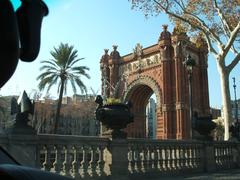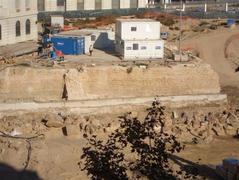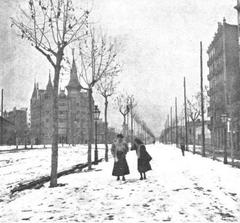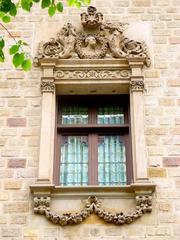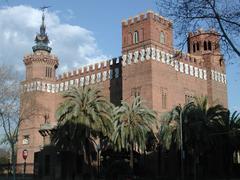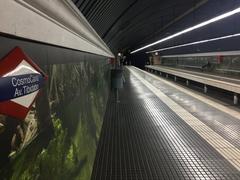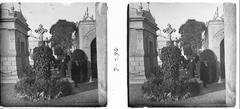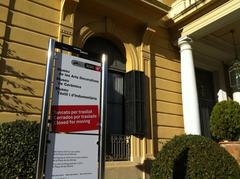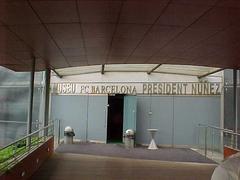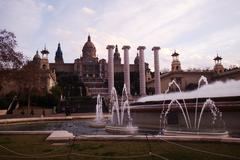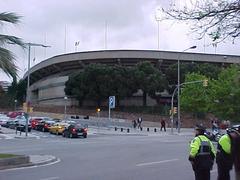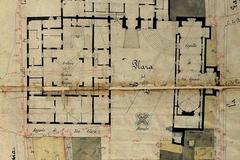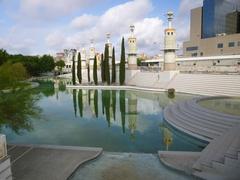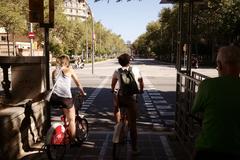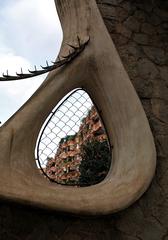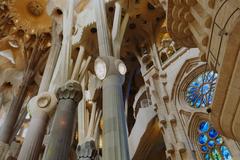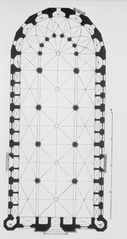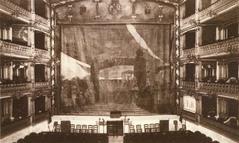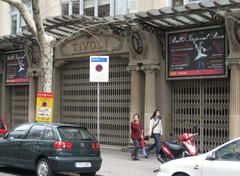Visiting Hours and Tickets for Jardins De La Rambla De Sants, Barcelona Historical Sites
Publication Date: 16/08/2024
Introduction to Jardins De La Rambla De Sants
The Jardins de la Rambla de Sants, located in the vibrant Sants neighborhood of Barcelona, Spain, is a unique elevated garden that has redefined urban green spaces since its inauguration on August 20, 2016. Designed by architects Ana Molino and Sergi Godia, this innovative project spans 760 meters in length and 30 meters in width, strategically placed over railway and metro lines parallel to Carrer d’Antoni de Capmany. The gardens were conceived as a response to local residents’ long-standing demand to cover the railway tracks that divided the neighborhood, ultimately opting for an elevated garden due to the prohibitive costs of moving the tracks underground (Wikipedia).
The Jardins de la Rambla de Sants is a testament to Barcelona’s commitment to urban renewal and sustainability. The garden integrates several eco-friendly features, including LED lighting, photovoltaic energy, and groundwater irrigation systems. It predominantly features native plant species such as jasmine, rose bushes, thyme, rosemary, and lavender, creating a botanical route for visitors (Barcelona by T). The structure of the garden, comprising prefabricated concrete boxes filled with glass, reduces noise while offering stunning views of the passing trains below, reminiscent of classic railway bridges (Wallpaper).
Table of Contents
- History and Significance of Jardins De La Rambla De Sants
- Visitor Information
- Social and Cultural Impact
- Economic and Urban Renewal
- Future Prospects
- FAQs
History and Significance of Jardins De La Rambla De Sants
Origins and Development
The Jardins de la Rambla de Sants is an elevated garden in Barcelona’s Sants neighborhood, inaugurated on August 20, 2016, and designed by architects Ana Molino and Sergi Godia. Spanning 760 meters in length and 30 meters in width, the garden connects the neighborhoods of Sants and La Bordeta (Wikipedia).
The garden was created in response to local residents’ demands to cover the railway tracks that divided the neighborhood. Initially, moving the tracks underground was considered, but due to high costs, an elevated garden was chosen as a feasible alternative. The first phase, completed in 2012, involved covering the tracks with a concrete structure known as “El Calaix de la Vergonya” (The Box of Shame), which isolated the tracks but still posed connectivity challenges (Wikipedia).
Architectural and Environmental Significance
The Jardins de la Rambla de Sants exemplifies Barcelona’s innovative approach to urban renewal and sustainability. It incorporates LED lighting, photovoltaic energy, and groundwater irrigation systems. The gardens predominantly feature native plant species, including jasmine, rose bushes, thyme, rosemary, and lavender, labeled with signposts to create a botanical route (Barcelona by T).
The garden’s structure comprises prefabricated concrete boxes in the form of Warren beams, filled with glass to reduce noise while allowing views of the passing trains. The top level features Mediterranean bushes, herbs, and miniature forests of rosewood and flowering Koelreuteria trees. Over time, creepers are expected to cover the triangular supports of the beams, filling the air with the scent of jasmine (Wallpaper).
Visitor Information
Ticket Prices
Entrance to the Jardins de la Rambla de Sants is free of charge, making it an accessible destination for both locals and tourists.
Opening Hours
The gardens are open to the public 24 hours a day, seven days a week, allowing visitors to enjoy the space at any time.
Accessibility
The elevated garden is designed to be accessible to people with reduced mobility. There are ramps and elevators available to ensure that everyone can access and enjoy the gardens.
Guided Tours
While there are no official guided tours specifically for the Jardins de la Rambla de Sants, visitors can explore the botanical route marked with signposts that provide information about the various plant species.
Nearby Attractions
Visitors to the Jardins de la Rambla de Sants can also explore other nearby attractions in the Sants neighborhood. Notable examples include:
- Parc de l’Espanya Industrial: A public park featuring postmodernist lighthouses and a lake.
- Parc de l’Excorxador: A former abattoir now filled with palm trees and a surreal sculpture by Joan Miró.
Social and Cultural Impact
The Jardins de la Rambla de Sants has had a significant social and cultural impact on the local community, providing a green space in a densely populated urban area. The gardens include various public amenities such as a shade house, playground, open-air fitness equipment, and a biblioparque (library park). Additionally, there is a permanent black and white photo exhibition titled “Sants, rails I vies,” showcasing the urban transformation around the railways from 1917 to 1998 (Barcelona by T).
Despite some criticisms regarding the loss of privacy for nearby apartment residents, the overall impact of the Jardins de la Rambla de Sants has been positive, transforming a previously neglected area into a vibrant public space (Wallpaper).
Economic and Urban Renewal
The construction of the Jardins de la Rambla de Sants was part of a broader urban renewal initiative aimed at revitalizing the Sants neighborhood. The project cost approximately 22.2 million euros and took 23 months to complete. By covering the tracks with a green space, the project has not only improved the aesthetic appeal of the area but also enhanced the quality of life for local residents (Wikipedia).
Other public parks developed in the Sants neighborhood include the Parc de l’Espanya Industrial, featuring postmodernist lighthouses and a lake, and the Parc de l’Excorxador, a former abattoir now filled with palm trees and a surreal sculpture by Joan Miró. These projects reflect Barcelona’s commitment to creating innovative and functional public spaces (Wallpaper).
Future Prospects
The Jardins de la Rambla de Sants is expected to continue evolving as a key public space in Barcelona. There are plans to extend the gardens further into the neighboring municipality of Hospitalet de Llobregat, enhancing connectivity and providing additional green space for residents. The gardens’ design allows for flexibility and adaptation, ensuring they can meet the changing needs of the community over time (Wikipedia).
In conclusion, the Jardins de la Rambla de Sants is a remarkable example of urban renewal and sustainable design. Its history and significance lie in its ability to transform a previously neglected area into a vibrant and functional public space, providing numerous benefits to the local community and setting a precedent for future urban development projects in Barcelona.
FAQs
What are the opening hours of Jardins de la Rambla de Sants?
The gardens are open 24 hours a day, seven days a week.
Are there guided tours available?
There are no official guided tours, but visitors can explore the botanical route with signposts providing information about the plant species.
Is there an entrance fee for the gardens?
No, entrance to the Jardins de la Rambla de Sants is free of charge.
What are some nearby attractions?
Nearby attractions include the Parc de l’Espanya Industrial and Parc de l’Excorxador.
Visit and Stay Up to Date
For more information and updates, follow us on social media or visit our website. Download our mobile app for more travel tips and guides on exploring Barcelona’s historical sites.


